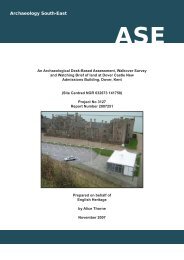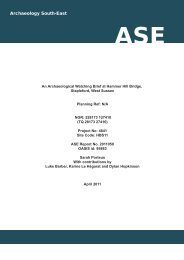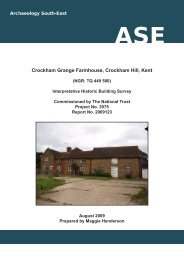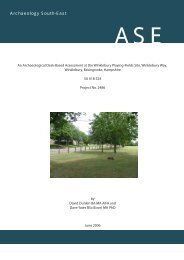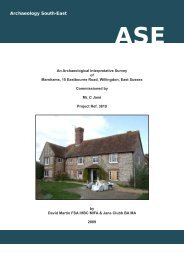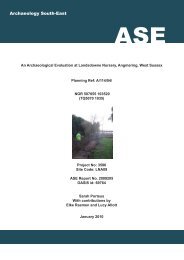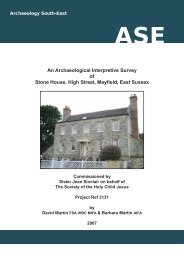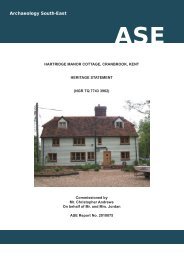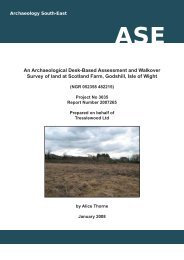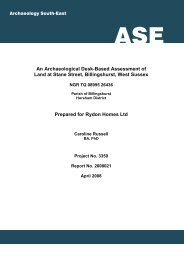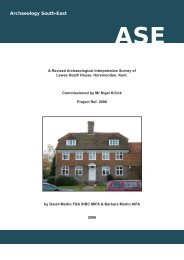ASE front cover - Archaeology South-East
ASE front cover - Archaeology South-East
ASE front cover - Archaeology South-East
Create successful ePaper yourself
Turn your PDF publications into a flip-book with our unique Google optimized e-Paper software.
<strong>Archaeology</strong> <strong>South</strong>-<strong>East</strong>2008058: Holbury Infants School, Holbury, HampshireAD 270 to the early/mid 4 th century. Whilst the pottery re<strong>cover</strong>ed from thelower fill [1092] was abraded and is possibly residual, especially as twoother sections produced pottery only of later AD 270 to the early/mid 4 thcentury date, it may represent an earlier phase of activity and reflect theperiod of time over which the linear was open and in use.4.3.6 The revealed plan shows that the two linear features could intersect to thesouth-eastern end of linear A and the northeastern end of linear B, to theimmediate northeast of the limit of excavation (Figure 5). It is possible thatthe two linear features formed part of an enclosure or partially enclosedarea and accordingly that the two linear features are contemporary. Six ofthe fill deposits from the linear features produced pottery dated to AD 270 tothe early mid 4 th century, whilst four fills produced earlier material; theprehistoric flint and Iron Age loom weight are clearly residual. It is also likelythat the abraded sherd of pottery dated to AD 120-200+ re<strong>cover</strong>ed from alower fill of linear B and the assemblage of pottery dating to AD 170-200+collected from the tertiary fill of linear A are residual. The sections throughthe two linear features were fairly uniform, suggesting that both of the linearfeatures were kept fairly clean during use and were intentionally in-filledover a fairly short period of time further indicating the probability that earliermaterial is residual4.4 Possible Hearths/ Pits (Figure 9, Sections 15 and 16 and Figure 11)4.4.1 The two possible hearths, [1051] and [1057], had multiple fills, the formationof which seemed similar and was comprised of burnt material betweencleaner fills with less burning. It is not clear if there is a relationship between[1057] and [1051] due to severe root damage across the surface of thearea, both having been truncated by probable tree throw [1050] (Figure 5and 9, Sections 15 and 16). There was a dense group of trees locateddirectly over the area of [1051] and [1057] and the associated rootdisturbance has clearly had a detrimental effect, rendering it difficult todetermine a direct relationship, if any. The resulting damage is furtherevidenced by the environmental samples, which contained modern weedseeds and produced a lack of archaeobotanical remains indicating thatmodern rooting has probably caused contamination and disturbance withinthe fills. However, samples taken from [1057] were dominated by burnt clayand support the interpretation of the feature as a hearth.4.4.2 Hearth/large pit [1057] (Figure 9, Section 15) was an irregular sub-ovalshape in plan. It had an irregular elongated D-shaped profile and an unevenirregular base. This area had been badly disturbed by root damage and[1057] had diffuse edges. It was truncated on its eastern edge by probabletree throw [1050]. Hearth/large pit [1057] contained 14 fills: [1129], [1127],[1128], [1121], [1126], [1105], [1124], [1125], [1108], [1059], [1107], [1122],[1106] and [1058]. The primary fill [1129] was comprised of re-depositednatural and was a greyish orangey brown sandy clay with occasional smallstones and occasional flecks of CBM and charcoal. The secondary fill[1127] was a greyish brown sandy silt with very occasional small pebblesand fairly frequent flecks of charcoal. The tertiary fill [1128] was a yellowishgreyish brown gravely silt with frequent small pebbles and gravel inclusions.The fourth fill [1121] was a greyish black silty sand with frequent burningand flecks of charcoal and occasional gravel inclusions. Pottery wasre<strong>cover</strong>ed comprising a large group dated from AD 300 to the early/mid 4 th10© <strong>Archaeology</strong> <strong>South</strong>-<strong>East</strong>



